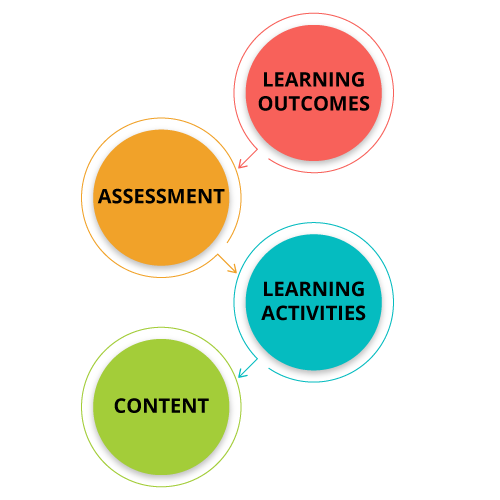5
In Gagné’s Nine Events of Instruction framework, Event 2 is about informing learners of the learning destination. In a quality online course, we start by letting learners know where they’re headed, i.e., what will they be expected to know, value, or do by the end of the course? We call this process backward design.

Credit: University of Waterloo
What is backward design?
Backward design is like a road trip—it helps us to answer the following questions:
- Where are we going?
- How will we get there?
- How will we know when we have arrived?

Credit: University of Waterloo
Backward course design starts at the end of the course by defining the learning outcomes we expect of our learners. Once we’ve decided what we want our learners to know, value, and be able to do by the end of the course (the instructional destination), we next determine the assessment evidence that will indicate whether learners have arrived at the desired destination. What kinds of assessments will we use to measure our learners’ progress toward the outcomes?
And lastly, we work out the learning experiences (activities and content) that will prepare our learners to achieve the outcomes and complete the assessments successfully. This is called alignment. In a well-aligned course, every element should support/align with the achievement of the learning outcomes: the content, the learning activities, and the assessments.
Why backward design matters
Backward design is important for both learners and instructors. For learners, it clarifies course expectations, i.e., what you expect that they should know and be able to do by the end of the course. This kind of transparency can help to guide the way they approach their learning in the course (Kolomitro & Gee, 2015), and increases their motivation to engage in course activities (Darby & Lang, 2019). As Nilson and Goodson (2018) explain, it’s important to explain to learners why
. . . you designed, organized, and developed the course the way you did. . . . Students do not assume that everything you do is well considered, or for their own good . . . and they have no idea of the research behind your choices. In fact, their perceptions of course quality and utility have an impact on their motivation and entire online experience. (p. 114)
For instructors, backward design helps to ensure that appropriate learning activities and content are selected, i.e., that they effectively support and prepare learners for the assessments, setting them up for success and mitigating any potential concerns about “busy work” and unclear connections between assessments and content.
Once we’ve done this crucial work, it is important to make it transparent to our learners, who might not otherwise understand why we’re asking them to engage in certain course activities. Showing them the relevance of what we’re asking them to do will increase their motivation to engage in course activities and promote their understanding of how to learn.
Quality Advanced
Strategies for “making course design transparent”
“Transparent teaching methods help students understand how and why they are learning course content in particular ways” (Winkelmes, 2014).
If you are interested in further exploring transparent teaching methods, take a look at the list of instructor-created examples of Transparent Methods from the Transparency in Teaching and Learning Project. This site will help you to generate ideas for providing explicit information to students about the teaching and learning practices you use in your course.
Examples of how backward design works
A useful way to ensure that your course is well-aligned is to complete an alignment chart (also known as a course map). An alignment chart lists the course and module learning outcomes and the associated assessments, content topics, and activities as they align to those learning outcomes. Module learning outcomes should align with course learning outcomes.
| Week | Module Number | Topics/Concepts | Learning Outcome(s) | Bloom’s Taxonomy Level | Activities and/or Assessments (e.g., quiz, written assignment, discussion) |
|---|---|---|---|---|---|
| 1 | |||||
| 2 | |||||
| 3 | |||||
| 4 | |||||
| 5 | |||||
| 6 | |||||
| 7 | |||||
| 8 | |||||
| 9 | |||||
| 10 | |||||
| 11 | |||||
| 12 |
Below we’ve provided some examples of alignment charts, at both the module and course levels, across several disciplines.
Quality Essential
Module-level alignment charts
- Example 1: English Literature course (PDF); Credit: Kate Lawson, Department of English Language and Literature, University of Waterloo.
- Example 2: Intro to Statistics course (PDF); Credit: Marie Lippens, WatSPEED, University of Waterloo (adapted from OpenIntro Stats).
- Example 3: Psychology – Basic Processes of Behaviour (PDF); Credit: Domenica De Pasquale, School of Interdisciplinary Studies, Conestoga College.
- Example 4: Capstone II – Organizational Consulting Project (PDF); Credit: Dubravka Bright, School of Business, Conestoga College.
Course-level alignment chart
In this final example, course learning outcomes are mapped onto course activities, and learner-centred language is used to set an inviting and accessible tone.
- Example 5: Cultural Identities – Truth-Reconciliation-Story (PDF); Credit: James Skidmore, Department of Germanic and Slavic Studies, University of Waterloo.
A (meta)example of how a course-level alignment chart could work
How we did this in this course
Your module learning outcomes should align with your course learning outcomes. Take a look at the Course-Level Alignment Chart (PDF) we created for this course to see how we aligned our module learning outcomes with our course learning outcomes.
Credit: Laura Shannon, Queen’s University
Activity: Module-level alignment chart
Learning outcomes
This activity is directly aligned with Course Learning Outcome (CLO) 2: Develop a set of learning outcomes for your online course that are explicit, assessable, and measurable.
Instructions
Equipped with the above examples to guide you, create your own module-level alignment chart/course map.
Option 1: Download the Module-Level Alignment Chart (DOCX) to create a Word version to complete offline.
Option 2: Complete the activity inline below. If you wish to save your inline results, be sure to download your work by clicking the Export tab at the bottom of the left-hand navigation bar in the activity before moving on.
Please note, this activity is intended for your own reflection and learning. Your responses are private and are deleted when you refresh or navigate away from this page.
Activity: Course-level alignment chart
Learning outcomes
This activity is directly aligned with Course Learning Outcome (CLO) 2: Develop a set of learning outcomes for your online course that are explicit, assessable, and measurable.
Instructions
Now that you’ve created your module-level outcomes, you’ll want to make sure that they align with your course-level outcomes. A good way to do this is to complete a Course-Level Alignment Chart.
Option 1: Download the Course-Level Alignment Chart (DOCX) to create a Word version to complete offline.
Option 2: Complete the activity in-line below. If you wish to save your in-line results, be sure to download your work by clicking the Export tab at the bottom of the left-hand navigation bar in the activity before moving on.
Please note, this activity is intended for your own reflection and learning. Your responses are private and are deleted when you refresh or navigate away from this page.

